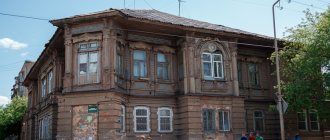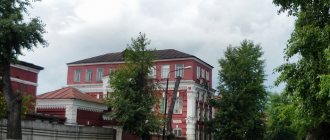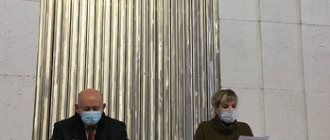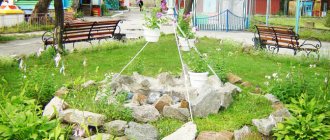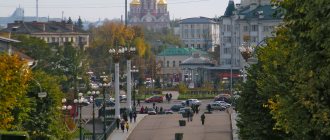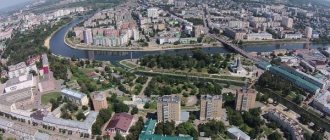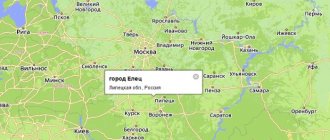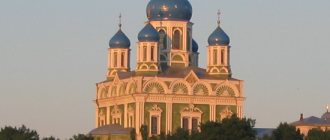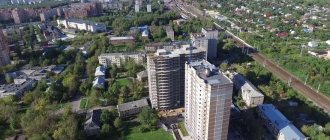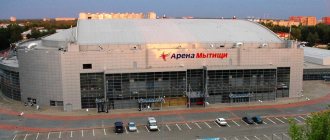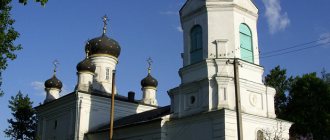Monument to customs officer Pavel Vereshchagin
The most famous monument of Kurgan. The bust of the hero of the film “White Sun of the Desert” is located near the Kurgan customs building.
The monument was erected on the initiative of the head of customs in 2007. The team supported the manager’s initiative, and the required amount was collected very quickly.
Address: st. Burova-Petrova, 132.
Monument Zero Kilometer
Many cities around the world have a similar monument. Residents of Kurgan decided: a monument to the Zero Kilometer should appear in their hometown. A bronze figure of a postman was installed in 2012 at the main post office. Now all roads are measured from this place.
The author of the project is local artist Boris Orekhov. Tourists often take pictures next to the postman.
Address: st. Gogol.
Mamayev Kurgan in Volgograd
There is another place in Russia called a mound. On the right bank of the Volga River in the Central district of the city of Volgograd is located Mamayev Kurgan. Sights of this magnitude are revered by all residents of our large country. It was here that fierce battles took place during the Battle of Stalingrad.
For this place, many people strive to visit Volgograd. Sights - Mamayev Kurgan, Motherland Calls - military in nature. On the territory there are graves of soldiers who fought for the country and were killed in these brutal battles.
Monument to Parents
Another project implemented by the Mama Foundation with the support of the residents and authorities of Kurgan. A couple expecting a baby - this is what a monument to parents looks like. Young people are dancing. The beautiful bronze sculptural composition looks touching and tender.
Address: st. Gogol.
There are several interesting exhibitions in Kurgan. One of the museums attracts the attention of all tourists.
Kurgan Aviation Museum
This exposition is the only one in the Urals and Siberia. Aircraft of various brands are located in an open area near the airport. Visitors to the unusual museum will be able to see airplanes and helicopters from different production periods.
Address: st. Gagarina, 41.
There are places in Kurgan associated with the names of the Decembrists. Tourists will be interested in the exhibition of the house-museum of V. K. Kuchelbecker. The museum, which contains exhibits telling about the life of the Decembrist poet, is the only one in Russia. The exhibition is located on the street. Kuibysheva, 19.
Alexander Nevsky Cathedral
The decision to build the temple was made in the winter of 1895. The bulk of the funds were donated by honorary citizen merchant D.I. Smolin. Other merchants and parishioners also contributed. As a result, with the money collected from the people, the temple of Prince Alexander Nevsky was built and consecrated on June 22, 1902.
In fact, it functioned until 1929. Then, over the years, a museum was organized here, converted into a gym, the Faculty of Mechanization of the Higher Party School, a clothing warehouse, and a planetarium. Only during the period of perestroika it was decided to use it for its intended purpose - the religious building was returned to the Orthodox community. Since the summer of 1989, the building began to be restored and revived. In 1993, the Alexander Nevsky Temple became a cathedral.
Decembrists Museum
In 1975, an exhibition dedicated to the activities of the Decembrists opened in the city. The museum is located in the house where Colonel M.M. Naryshkin lived since 1832.
Letters have been preserved, thanks to which it was possible to restore the exact interiors of all rooms and the internal layout. The façade looks the same as it did in the 19th century. In the museum, visitors will be able to feel the breath of past years and see hundreds of interesting exhibits.
Address: st. Klimova, 80.
Cathedral Mosque
Muslim tourists can visit the cathedral mosque located in the city of Kurgan. It was built in the 2000s. The mosque is located in the city center.
There was previously a mosque on the territory of Kurgan, opened by Amfrozan Galiev in 1910. During the Soviet period, this religious institution was abolished, and a Tatar-Bashkir school was opened in its building.
Location: Sibirskaya street - 2.
Art Museum
Museum workers quite rightly believe that the collection collected within the walls of the museum is unique. There are no similar exhibitions in the Kurgan region, numbering thousands of works by contemporary artists from different regions of Russia.
Visitors will see paintings by N. Dormidontov, O. Sokolova, A. Deineka, G. Shegal and many other authors. The museum often hosts creative meetings and exhibitions dedicated to memorable dates in the history of Kurgan and the region.
Address: st. Maxim Gorky, 129.
Historical data
From history textbooks we know that, starting in the 17th century, Russia expanded into the resource-rich lands located beyond the Ural ridge. At first, these were small Cossack detachments that pushed the Khan’s army into the depths of Siberia. And today thousands of tourists want to get to Kurgan. The sights of the city will not leave anyone indifferent.
Colonization did not bypass the territory of the current Kurgan region, which was once inhabited by Bashkirs, Kalmyks, and Kazakhs. The first Russian settlement was built near the Tsarev Kurgan, near which the Tobol River flows. The location for the Tsar's settlement was chosen for a reason; it was a strategically important point. From time to time, the settlement was destroyed as a result of raids by local Kazakhs. However, the village was restored each time by its inhabitants.
Tsarev Kurgan was a truly enormous bulk structure. In the 60s of the 20th century, local authorities considered its further existence unnecessary. Thus, the historical name remained from the giant mound. At the same time, it was decided to preserve other attractions for posterity.
Almost 100 years after its founding, in 1782, the settlement acquired the status of a city, which consisted of the Old and New Towns. The first of them was inside the second. The old city is represented by the Kremlin, the gates of which are quite reliable, since they were double. In the New Town, in addition to residential buildings, there were warehouses with military equipment, military barracks, and a gunpowder cellar. The outside was protected by 8 very powerful bastions, behind which an additional wide ditch was dug around the city.
Governor-General Kashkin’s great merit in the radical reconstruction of Kurgan. According to the master plan they developed, at the end of the 18th century it was planned to divide the city into quarters, and those consisted of streets. The Tobol River, or more precisely the direction of its flow, served as a landmark for the buildings. Rich townspeople could afford to build houses made of stone; the rest of the population settled in wooden buildings. The industry of that time was represented by three forges, one soap factory and two tanneries. One parish is organized for church services.
It took another hundred years for the city to become a trading center where one could buy bread, butter, lard and meat. Industry mainly existed at the expense of raw materials supplied by agricultural producers. This is how the city of Kurgan developed. The sights of the settlement should be seen by everyone who finds themselves in this area.
The Trans-Siberian Railway project served as a significant impetus for the development of the city, and its new life began. This period was marked in the history of the city by the construction of more than sixty factories and factories, and a new direction in gardening appeared - growing tobacco. Kurgan developed at a rapid pace. The sights of the city will be of interest to everyone who loves museums and monuments.
At the beginning of the 20th century, the first plant in Russia producing water turbines was launched. Literally from the first days of the Great Patriotic War, according to the historical order of the country's leadership, enterprises were transported from the western regions to Kurgan, as well as to many other cities of the Trans-Urals, and quickly put into operation. This circumstance contributed to the emergence of Kurgan as a huge industrial center with developed medical and educational institutions.
Kurgan Museum of Local Lore
The museum's exposition is one of the richest in the vastness of Siberia and the Urals. More than 200 thousand valuable exhibits cover the period from the primitive system to the present.
Thematic exhibitions are organized in the halls of the museum, which contain archaeological and paleontological finds, ancient manuscripts, silver and metal jewelry, ancient weapons, household items, photographs and archival documents.
You can spend the whole day in the halls of the museum. Come early. The museum is open from 9 a.m. to 5 p.m. Monday is a day off.
Address: st. Pushkina, 137.
City History Museum
Visit the merchant mansion that belonged to the merchant of the 1st guild S.I. Berezin. This stone urban-type estate is the only one in the vast Trans-Urals that has preserved an enclosed courtyard with a central house and outbuildings.
The 19th-century estate contains documents, photographs of city streets, and personal belongings that belonged to famous citizens. Visit the museum on the street. Kuibysheva. On the same street there is the house-museum of the Decembrist V.K. Kuchelbecker.
Address: st. Kuibysheva, 59.
Fire Tower
One of the oldest symbols of the Kurgan. The city government in 1877 decided to build the structure that the city needed. Four years later, the stone fire building and tower were put into operation.
Today the fire complex of the 19th century is an architectural monument. A firefighter dummy is installed on the tower.
Address: st. Kuibysheva, 62.
Puppet theater "Gulliver"
The creation of the Kurgan Puppet Theater was conceived during the Great Patriotic War, at the end of the summer of 1943. However, the theater troupe did not have a building for a long time; the performances were on-site. In 1948, puppeteers were sheltered by the regional philharmonic society.
And the year 1949 was marked in the life of the theater troupe with the premiere of the play “The Scarlet Flower,” which took place on the puppet theater’s own stage. Over the entire period of creative activity, the troupe has been recognized as one of the best not only in Russia, but also in France.
The Gulliver Puppet Theater deserves to be called a landmark of Kurgan, for the reason that it is one of the first cultural institutions of this kind. Everyone who finds themselves in Siberia should look at Kurgan. The sights of the city will appeal to anyone who loves old buildings and interesting monuments.
